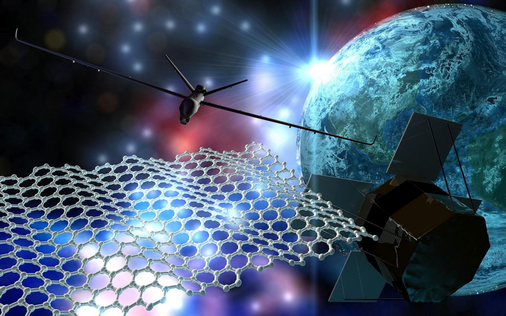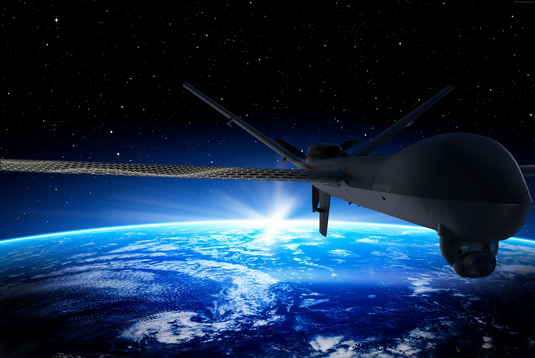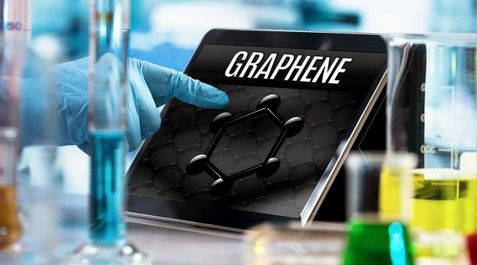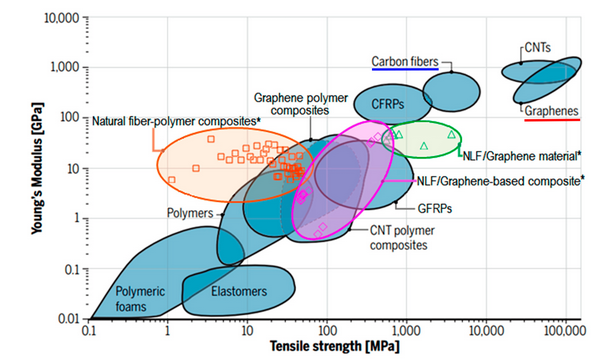Technology

Graphene was discovered in 2004 by Andre Geim and Kostya Novoselov, professors of the University of Manchester (Nobel Prize Winners in Physics in 2010). It consists of a single layer of carbon atoms bound in a hexagonal pattern. Its features make it an excellent candidate for various applications in aerospace as well as in aeronautics: it is a million times thinner than paper and is 200-300 times stronger than steel.
Since its discovery, graphene provoked an immediate craze from the scientific community. It must be said the finest crystal known, which is found naturally in graphite crystals, is ultra-resistant, transparent and is an excellent conductor of electricity. These properties make graphene an ideal material for the aerospace industry.
 Lighter aircraft, UAV, sturdy and invisible to radar. These are just some of the incredible applications of graphene, the wonder material made from a single layer of carbon atoms, in the aerospace sector. Graphene is revolutionizing not only Earth but also Space. The heat dissipation capacity of graphene allows producing ever smaller and more competitive for electronics and microelectronics products in aerospace sector. Lightweight, strong and flexible, the material is an ideal ally for aeronautics. Graphene has properties that could be useful in low gravity.
Lighter aircraft, UAV, sturdy and invisible to radar. These are just some of the incredible applications of graphene, the wonder material made from a single layer of carbon atoms, in the aerospace sector. Graphene is revolutionizing not only Earth but also Space. The heat dissipation capacity of graphene allows producing ever smaller and more competitive for electronics and microelectronics products in aerospace sector. Lightweight, strong and flexible, the material is an ideal ally for aeronautics. Graphene has properties that could be useful in low gravity. In the future, solar sails will probably be built to travel between the stars, space lifts to carry satellites and astronauts into orbit without using fuel, but also ultra-light, super-resistant and invisible to radar. Graphene, thanks to its high electrical conductivity, will be used not only to create de-icing systems integrated into the wings, but also to produce paints that reduce the radar footprint.
The key to the development of all these technological innovations is graphene, the 'wonder material'.
Graphene is really more than other advanced technologies of our time: artificial intelligence, virtual reality.
Graphene is a material on the basis of which thousands of technologies can be developed.
In this regard, it should be noted that graphene, its components and composites are a basic step towards an even grander direction - the study and use in the next decades of other two-dimensional materials, some of which are close to graphene in properties, and some of which are superior to it in a number of parameters.
Another class of gadgets that graphene is expected to spawn are ultra-sensitive cameras and sensors.
Optical sensors based on graphene will expand the range of action hundreds of times, provide visibility in bad weather and lack of light, and will be able to "see" objects through. This is relevant not only for security cameras, but also for UAVs.

Lightweight graphene composites, additive manufacturing and innovative aero engine systems are helping to reduce emissions and weight of today's airplanes and UAVs, helping to reduce carbon emissions.
Lightweight graphene composites
Graphene composites, known for their unique processing capabilities, lightweight properties and strength, are increasingly being used in the aerospace industry to replace various carbon composite parts.
IC Aerospace Group is a technology leader in graphene composite UAV structures, reducing the weight of UAV structures by up to 230% compared to traditional solutions such as carbon composites.
Graphene, as a radar-absorbing material, offers a range of benefits due to its unique properties. Firstly, graphene exhibits exceptional electrical conductivity, allowing it to effectively absorb and dissipate electromagnetic waves. This results in reduced radar reflection and enhanced stealth capabilities.
Additionally, graphene is lightweight and flexible, making it suitable for various applications, including coating surfaces of military aircraft and unmanned aerial vehicles (UAVs). Its thin and compact structure enables seamless integration into existing systems without compromising aerodynamics. Moreover, graphene-based radar-absorbing materials have the potential for wide bandwidth absorption, covering a broad range of frequencies. This versatility makes graphene a promising candidate for next-generation radar-absorbing materials, providing improved performance and efficiency in radar systems. Overall, the benefits of graphene as a radar-absorbing material lie in its high conductivity, lightweight nature, compatibility with existing systems, and broad frequency absorption capabilities.
Functionalized graphene conductive composites. The stealth capabilities of UAV are greatly enhanced, or it will bring revolutionary changes in the research process of stealth technology or absorbing materials.
The main purpose of radar stealth is to reduce the UAV's radar cross section (RCS). The main measures usually include: a unique aerodynamic shape design, that is, through a special shape design to control the direction of the radar echo, the use of absorbing materials and absorbing structures that can absorb radar waves, so that the scattered field is weakened, and no effective return is formed.
The great Victorian physicist and mechanic Lord Kelvin said the famous phrase: "If you can not measure it, you can not improve it"
He didn't say that exact quote. His actual quote:
I often say that when you can measure what you are speaking about, and express it in numbers, you know something about it; but when you cannot measure it, when you cannot express it in numbers, your knowledge is of a meagre and unsatisfactory kind; it may be the beginning of knowledge, but you have scarcely, in your thoughts, advanced to the stage of science, whatever the matter may be.
Fully share the view of Lord Kelvin, we have made a telemetry complex that allows you to measure in real time, with high accuracy, such parameters of a racing bike as: inductive resistance, power, torque, speed, all aerodynamic indicators, etc.

We have developed and manufactured experimental components for racing bikes using graphene composites wheels, transmission, frame, aerobar - for track and road. Premiere track testing of wheels and transmission increased the efficiency of a track bike and, as a result, set several World Records.
The premiere use of the graphene transmission on the road took a place at the Tour de France and the 2023 World Championships with the Astana Qazaqstan Team (WT). The results of the joint testing of graphene transmissions in competition conditions fully confirmed the performance indicators.
The efficiency of a racing bike as a system depends on many factors such as:
- the weight and stiffness of the wheels and their aerodynamics;
- the segregated stiffness of the frame and its aerodynamics;
- the radical reduction of friction in the transmission;
- radical reduction of inductive resistance of the wheels and frame;
- reduction of wheel tyre hysteresis
The use of graphene composites can significantly increase the efficiency of racing bikes.

